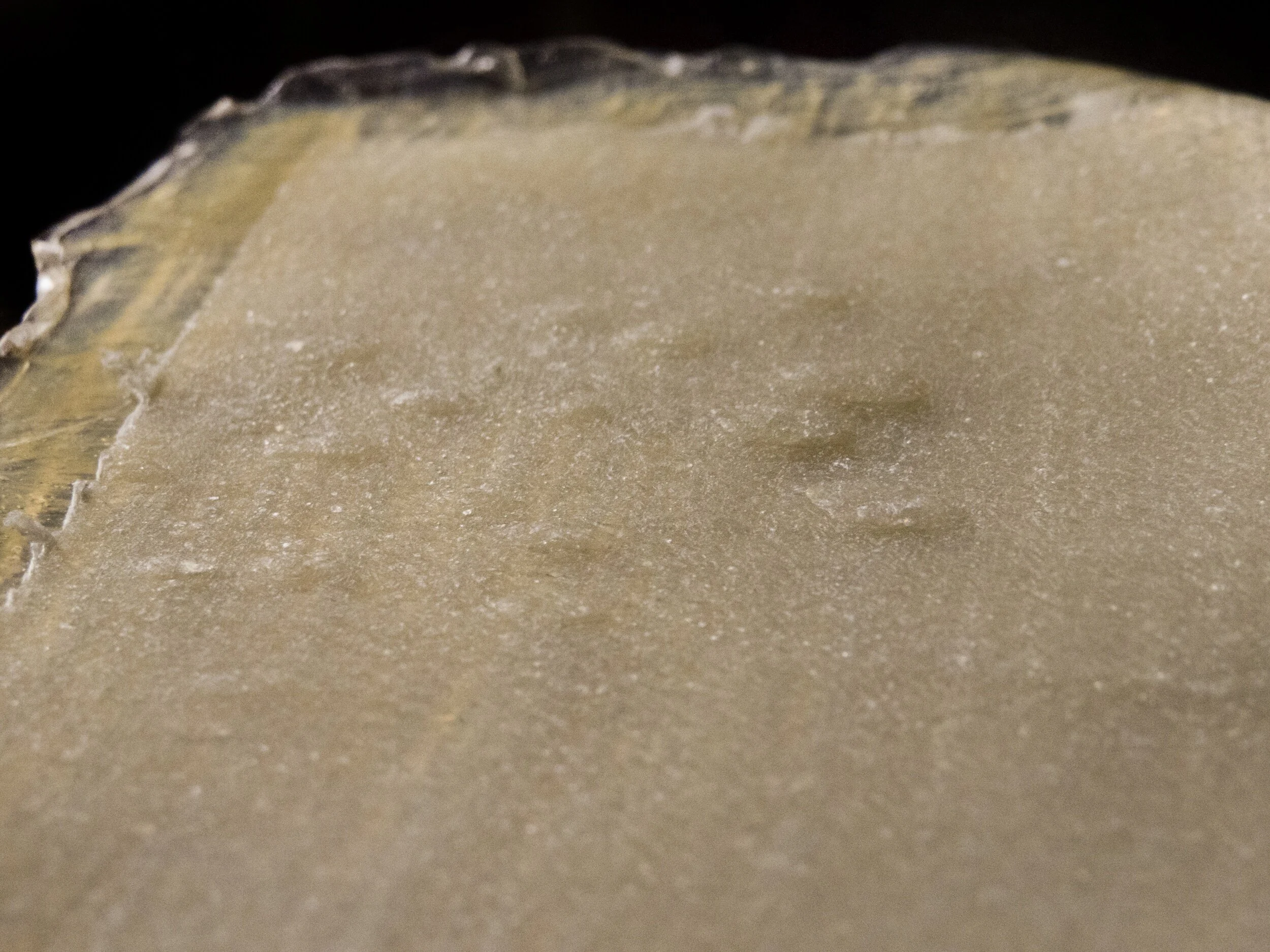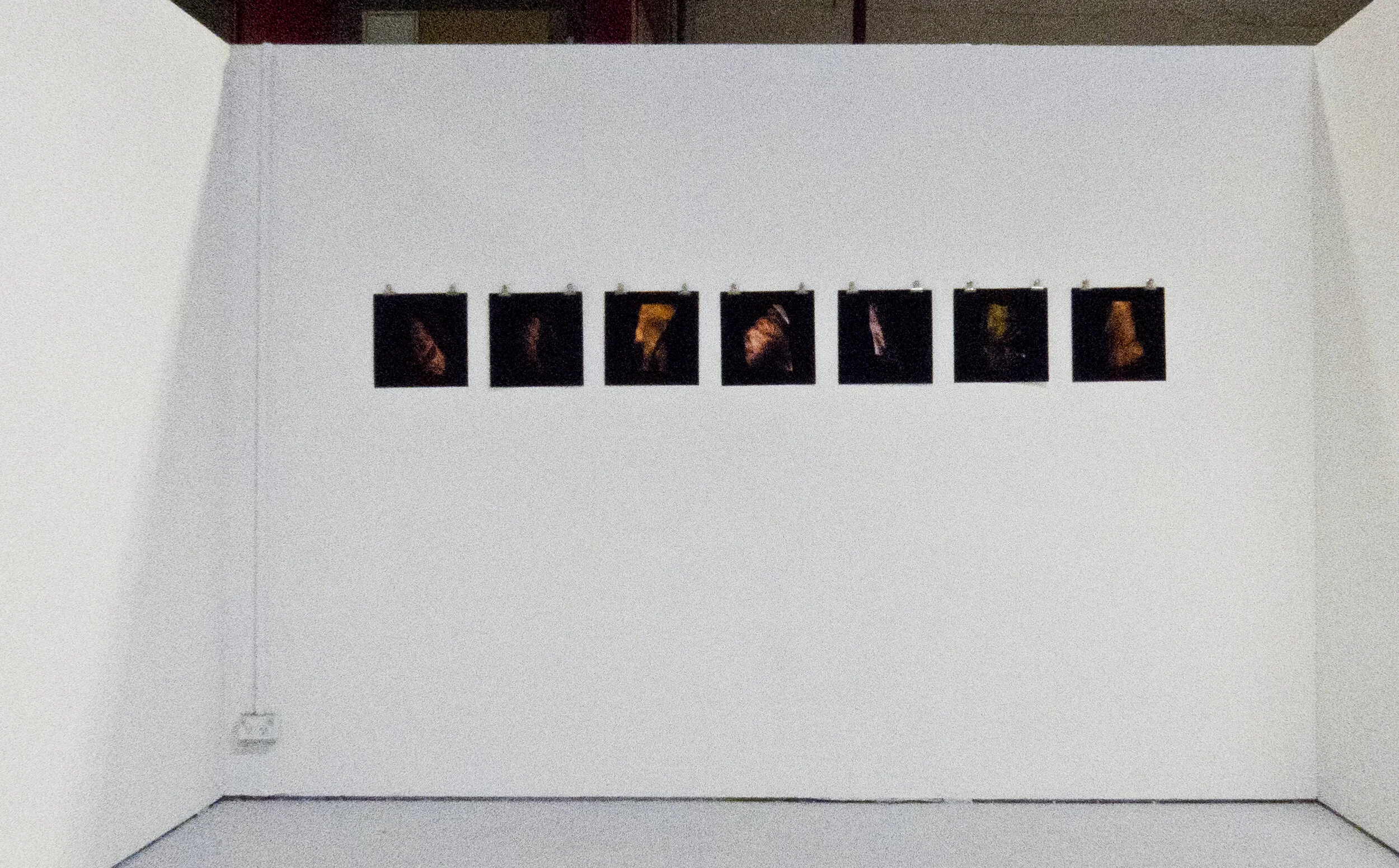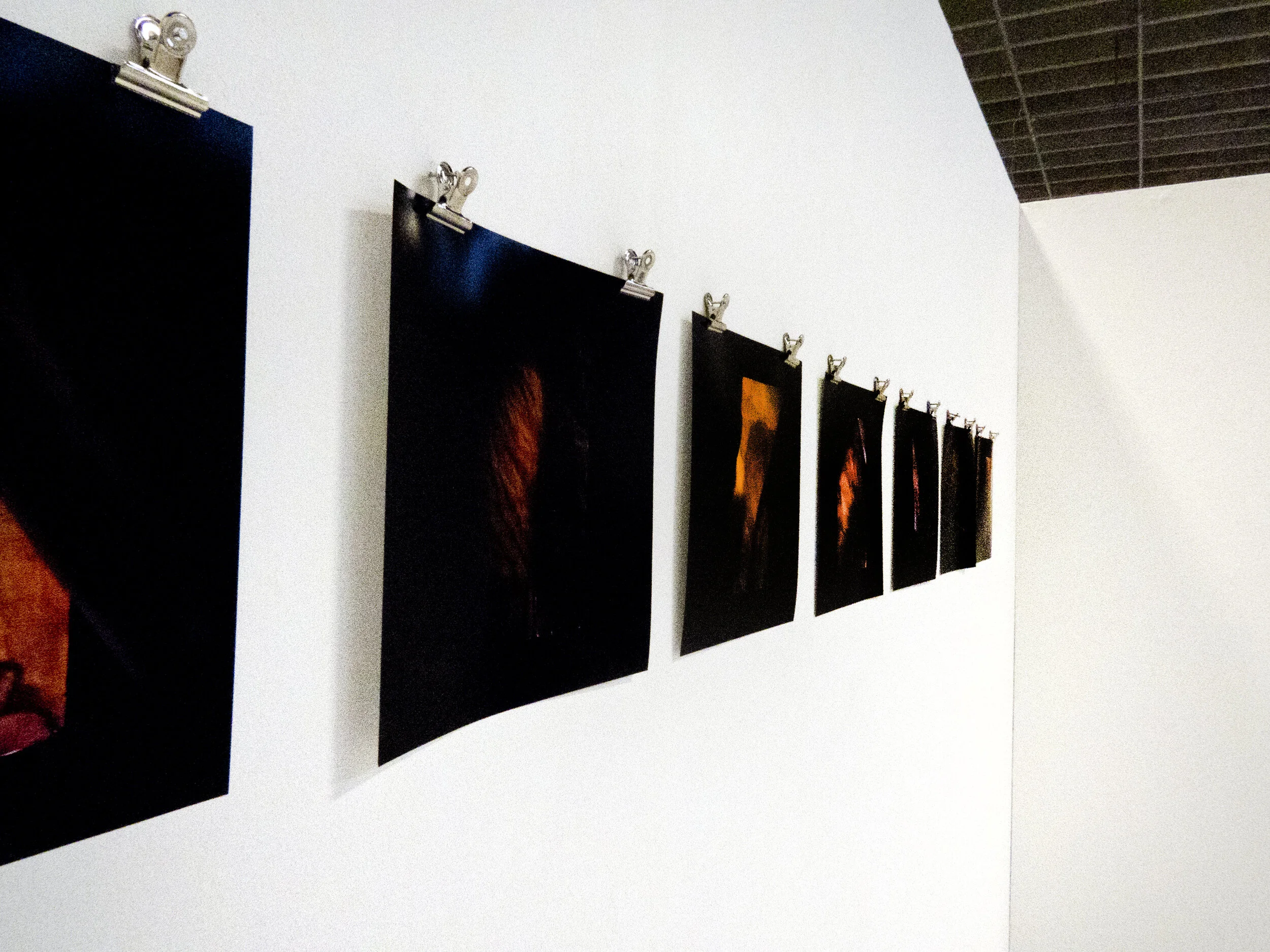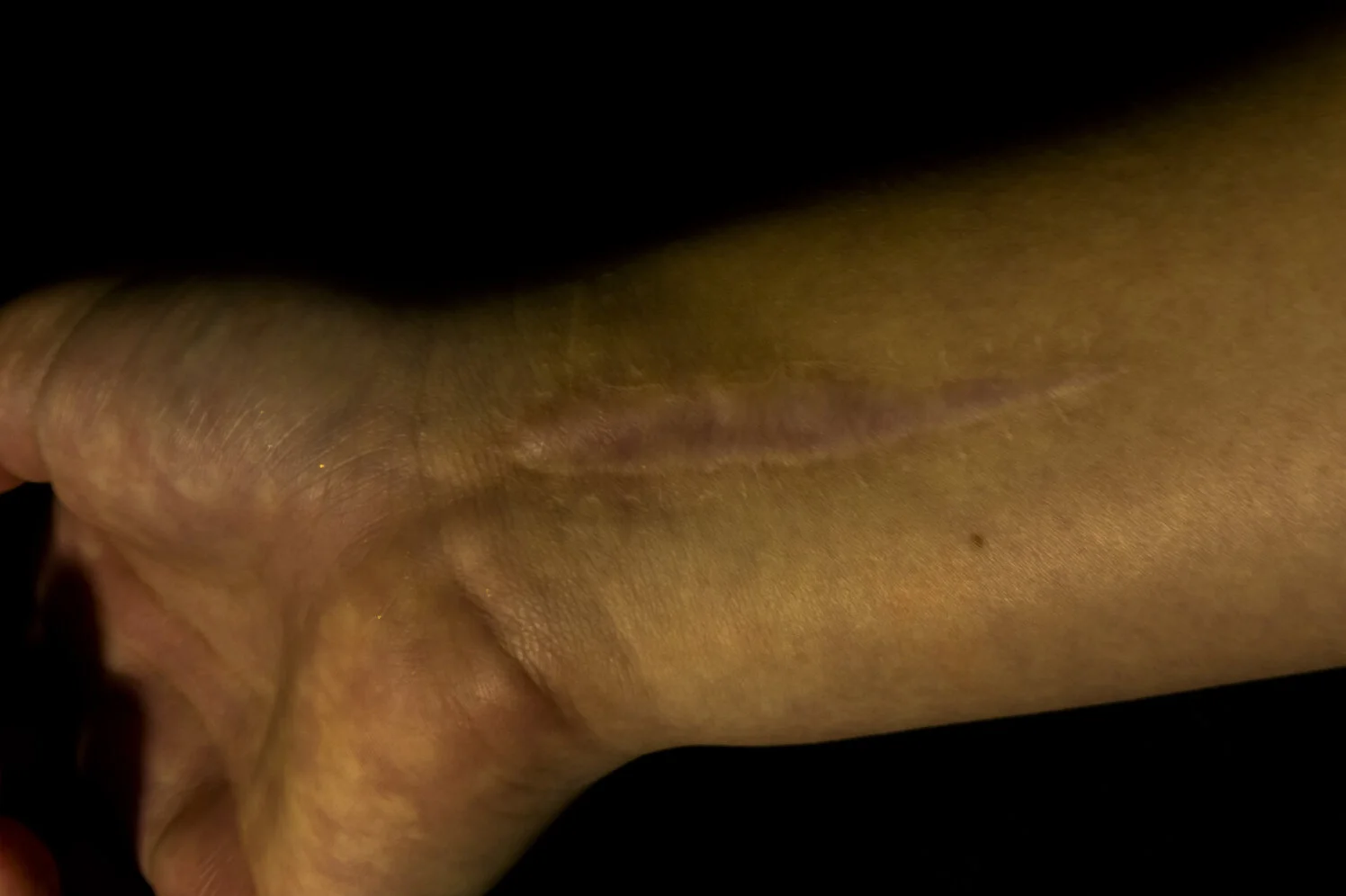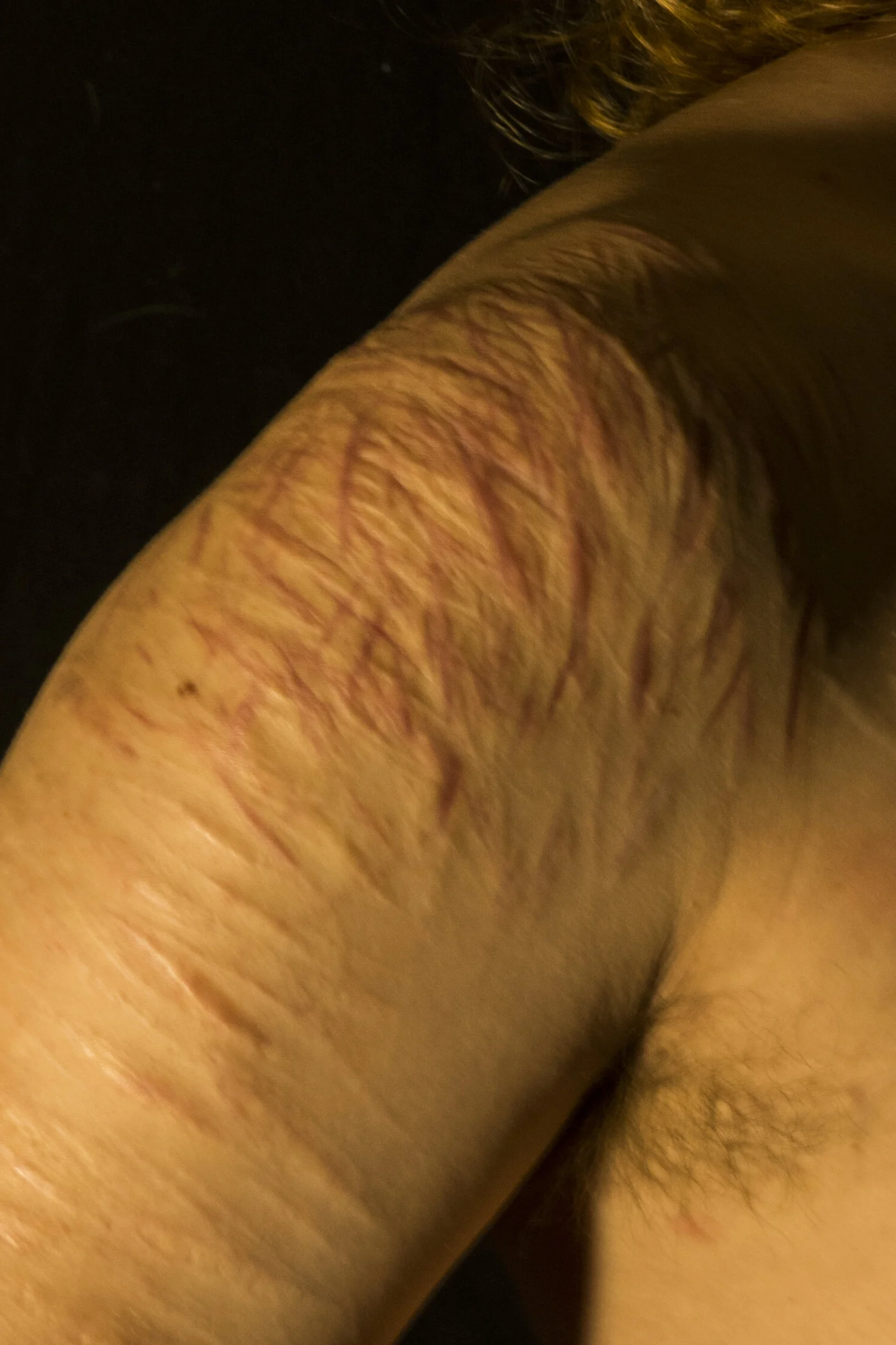I am interested in elevating these often overlooked marks and traces through the employment of archival strategies. These perspex display cases have been made to the scale of the lifts. I have chosen to mount the lifts inside so that they are suspended and raised at a level that allows you to observe it clearly. The perspex cases have been designed with a curved edge to limit visual interference when observing the objects inside. This design has been modeled closely after existing display mechanisms used in museums. I would like to explore discreet alternative options for mounting the latex reliefs such as foam mounts and metal pins.
Contextual Statement July 2020
“The skin figures. It is what we see and know of others and ourselves, we show ourselves in and on our skins, and our skins figure out the things we are and mean.” 1
Skin is a visual signifier not only of our identity but a record of our lived experiences. “Skin re-members, both literally in its material surface and metaphorically in re-signifying on this surface.” 2 Jay Prosser implies that meaning is ascribed to skin and can be read by others like a document. Skin can be a form of archive; a site and sight for the memory of our encounters. Conveying past and present, this visual record anchors memory through the traces on its surface.
Preserving the residual traces on my own skin, I aim to elevate these overlooked markers of history through an autobiographical lens. Isolating these fragments by utilizing a medium that has indexical properties and employing archival strategies, I aim to highlight the complex relationship between the represented and the representation. These degenerate copies have an existential connection like photographs and retain a ‘having been thereness’ to the objects they portray. 3 The index is susceptible to degradation and is not a pure simulacrum but a shadow that ‘casts off’ evidence of life beyond its exterior. 4 This tension between skin as both a site of the abject and boundary questions the indexical relation and status of separation to the signified. Neville Wakefield refers to this separation as a ‘'space of release,’' a gap that is ‘'heavily impregnated with memory,’' where lived encounters are just as suggestive with corporeal memory as with mental connections. 5
Abigayle McLean
Synecdoche
Latex mounted in perspex display cases, 150cm x 150cm x 150 cm
Synecdoche
Latex mounted in perspex display cases, 150cm x 150cm x 150 cm
Steven Connor, The Book of Skin, (Reaktion Books Ltd. London,2004) 31
Jay Prosser, Skin Memories: Thinking Through the Skin edited by Sarah Ahmed and Jackie Stacey, (Routledge, London, 2001) 52
Roland Barthes, Camera Lucida, (Vintage, London, 2000) 85
“Art Term: Abject Art,” Tate, accessed June 4, 2020, https://www.tate.org.uk/art/art-terms/a/abject-art
Neville Wakefield, Separation Anxiety and the Art of Release, (Parkett, 42, 1994, 77-78)
Photoshoot: Latex Under Natural Light
In this particular series, I experimented with photographing the latex reliefs I have made in natural light. I enjoy how the softer light allows the transparent nature of the lifts to be visible and adds a sense of weight to them as objects. I found that folding the latex on top of itself as if it were skin enabled animation of the reliefs.
April Seminar Virtual Installation
My work aims to explore the notion of preserving and anchoring memory through an indexical relationship by capturing the traces on the surfaces of my skin. ‘Soft Clock’ is a digital photographic documentation of a series of inverted latex castings from my skin. Corporeality is lost through the degradation of photographic and casting processes, enabling a co-extensive relationship between residual memories and the life of the object.
I am interested in the concept of the infra mince, ‘a liminal space by which both the fact of the object and its representation and imaginings and associations overlay one another.’ (1) This space of release is a charged gap, defined by the properties of the medium, the nature of the representation and the memories carried by it, taking on a life of its own.
Abigayle McLean
List of Works:
Soft Clock
Digital photographs, 131.8 x 123.8 x 1.0 cm
1. Joan Gibbons, Contemporary Art and Memory, Images of Recollection and Remembrance, 2007), 31
Latex Skin Reliefs
I have been investigating applying latex directly to the surface of my skin to cast the scars that mark my encounters with the world. This particular cast was made from a mark on my arm that was caused by an allergic reaction. Latex, materially, has skin-like qualities and has to be layered on to create a second skin, which is then peeled off once it is thick enough to maintain its own integrity without support. This process creates an inverted negative and is, therefore, not a pure representation of the original mark. This technique is present in the works of Rachel Whitehead and Heidi Bucher, who both cast directly from the surface of objects and spaces. I aim to explore this casting process further and attempt to remove the rough edge present from the casting application, as well as explore different layering techniques such as dipping and sponging.
This material study also opens up questions around representation versus the represented object and the interference or degradation that takes place within the medium’s properties. How do the medium’s properties define the traces it carries?
Key Questions
Skin as a site or sight for memory is the key concept that informs my practice in which I question the following: how does our approach to observing the skin have significance on the way we represent ourselves and others in portraiture and contemporary visual culture? How can skin as a medium and archive be analyzed and documented to inform how we communicate and experience embodiment? Engaging with individuals and the marks on their skin, I make work through a collaborative process that examines ideas of representation, trauma, and authenticity. Through the use of analogue photography and video installations, I aim to foster a singularized experience through materiality by disidentifying with other reproducible digital forms. Focusing on the epidermal likeness and anonymity of the subject, I use ‘skin portraiture’ as a method to disrupt traditional portraiture, and in turn also act as a form of protection for the individuals involved.
Amy Kathryn Watson in Complexion: Skin, Surface and Depth in Contemporary Art Practice, presents her interpretation of skin’s role as “a medium of passage, interchange and the vehicle in which our other senses are embedded.” 1 Watson employs a phenomenological approach of unpacking skin as a medium, material and metaphor by rationalizing with and through the skin. “Thinking through the skin is a thinking that attends not only to the sensuality of being-with-others, but also to the ethical implications of the impossibility of inhabiting the other’s skin.”2 Applying this phenomenological lens as a strategy to inform my process of making and thinking is vital to understanding the physiological components of skin and what it is to inhabit one.
“Skin is a liminal structure, it is in-between, it is the template on which our experience, inner and outer, is inscribed, and our experience and our inheritance is there to be read by others. It is where the world confronts the I and the I meets the world.”3 Mundi suggests that meaning is ascribed to the skin, and the skin is further opened to being read and interpreted. Skin has the ability to act as a “soft clock”4 highlighting Steven Connor’s sentiment that skin is an autobiographical record. Guiding our representations of skin, skin metaphors are a part of a language, which in turn shape and reinforce our relations with our own skin and those of others.
Documenting these traces on individuals' skins and utilizing skin portraiture as a method is integral to accentuating these signifiers or memory tethers. Through the magnification, fragmentation and anatomization of the epidermis, this abstraction of the body through skin portraiture makes the subject anonymous, only identifiable by the differentiating marks present on these skinscapes. “Skin portraiture highlights how our outermost edge communicates the vicissitudes of embodiment across bodies.”5 This technique makes me consider skin as a mediator and filter that is able to convey embodiment. In turn, this also makes me question how the autonomy of the portrait and body through skin portraiture disrupts the boundaries between the object and subject. By combining a phenomenological approach with the use of skin portraiture as a technique, I intend to open up the testimonies documented to a comparative manifestation when witnessed.
References:
1. Watson, Amy Kathryn, ‘'Complexion: Skin, Surface and Depth in Contempoary Art Practice.’' (PhD diss.., University of the Witwatersrand, 2010), 9.
2. Sarah Ahmed, Jackie Stacey, Thinking Through the Skin (New York: Routledge, 2001), 7.
3. Veronica Mundi in, Heide Hatry: Skin, ed. Heide Hatry (Berlin:Heidleberg, 2006), 22 .
4. Steven Connor, The Book of Skin, (New York: Cornell University Press, 2004) 46.
5. Heidi Kellet, “Skin Portraiture: Relational Embodiment and Contemporary Art,” in Probing the Skin: Cultural Representations of Our Contact Zone, eds. Caroline Rosenthal and Dirk Vanderbeke (Cambridge Scholar Publishing, 2015) 1
Studio Reflection
In my practice, I have continued exploring the idea of scars as a vessel for memory, specifically focusing on an individual. Some main points of focus for this project have been:
1) Collaboration:
I have been working closely with Tira who is the subject of this work. Tira has been a friend of mine for two years. I knew very little about her scars or her history until recently when she volunteered earlier this year to be a part of my project. I advertised this online through social media to close friends in order to build on an established relationship of trust due to the level of vulnerability expected from participants.
After the last seminar, it became clear that I needed to have a deeper look into the individuals I was photographing to unpack their stories and tease out the connections they had to their scars. I decided to establish an open dialogue with Tira in my work, which was achieved by:
Regular discussions about research and concepts
Tira wrote a letter in response to the photographs with the intention of presenting it as an element of the overall work. Having the letter as a part of the work is significant in allowing Tira to have a voice in the portrayal of her body. This letter was handwritten and is a personal account of the memories she associates with her scars over time.
Titling of the work. We decided her name, Tira, would be a fitting title, as it means ‘To Journey’ in Māori, which reflects her personal experience with her scars.
2) Ethics of Care
From the feedback I was given in the last seminar’s crits, I realised that the approach that I described as a caring one was not evident in the work. I have been researching Ethics of Care (EOC) to establish a basic outline of what this would look like and how it could be applied to my practice.
Ethics of Care in Practice:
Persons are understood to have varying degrees of dependence and interdependence on one another.
Having a collaborative relationship with Tira, where she and I both have a voice in making the work. This will be visually represented in the work by having the letter present.
Individuals affected by the consequences of one’s choices deserve consideration in proportion to their vulnerability.
A written contract that outlined my intentions for the work, including the subject matter I would be discussing. This also allowed her to dictate whether she wanted to be anonymous or not and her level of involvement.
Details determine how to safeguard and promote the interests of those involved.
Some Research Links:
https://www.iep.utm.edu/care-eth/
https://en.wikipedia.org/wiki/Ethics_of_care
3) Visual Symbol of Care:
I have been researching how to reflect a caring approach in my work. This led me to investigate Native NZ Flora that was traditionally used for healing. Rongoā Māori is the traditional Māori healing system. This ancient lore, including plant use, massage, and incantations, has been passed down through many generations.
In traditional Māori medicine, ailments are treated in a holistic manner with:
spiritual healing
the power of karakia
the mana of the tohunga (expert)
by the use of herbs
With the help of Tira, we looked into native plants that were used externally to treat open wounds and cuts, such as Kawakawa and Kowhai. I have been experimenting with how I could include this element in the work. The reasons to incorporate plants like these are to:
1) Create context around my work and connect it to NZ
2) Have a reparative approach which I feel reflects Tira’s journey with her scars.
3) Plants have also been used as a symbol in art for the passage of time and are a consistent reminder of our mortality.
https://herbs.org.nz/kawakawa-fact-sheet/
https://www.tepapa.govt.nz/discover-collections/read-watch-play/maori/maori-medicine
https://www.healthnavigator.org.nz/health-a-z/r/rongo%C4%81-m%C4%81ori/
https://meaningoftrees.com/2017/07/24/kawakawa-piper-excelsum/
4) Material Experimentation with Polaroids
I have been experimenting with polaroids after doing some research about Catherine Opie and her practice. I felt particularly connected to the idea of a polaroid being the purest photographic representation of an event as it can’t be edited. Polaroids also seemed fitting as a material choice as they function differently from digital images and are often used as personal objects of memory.
(Catherine Opie: A World Beyond Selfies Interview) https://youtu.be/fhK44-3CTfs
This particular video also made me question how we look at images now in a digital age and what kind of space I will need to create to engage with others. I have been pursuing the concept of making a space that is intimate and allows people to engage at a similar level. This became influential behind the curatorial decision of presenting my work in archival wooden display boxes.
July Seminar Installation Reflection
[Installation View] St Georges Bay Studio, Whitecliffe College of Art and Design, Auckland, New Zealand, 2019
Reflections:
The body is a limitless site for artistic exploration. I am currently inquiring into the notion of skin as a site or sight of inscription, drawing attention to the marks that bear testament to our experiences of embodiment.
Expanding the contextual field and delving deeper into the historical legacy left by artists who explore the body is vital to developing my practice and thinking. This may lead to exploring the performative aspects of the body and its exploration in performance art.
Evaluating the treatment of the individuals documented and represented. My work so far has been made in multiples with a variety of different individuals unified by the aesthetic and chosen media format of presentation. Due to the fact that I am portraying individual stories instead of a collective, changing my approach to reflect this is necessary in order to establish a singular focus on each individual depicted. This could be explored through having a collaborative practice and utilizing writing, audio, or performance as a platform to provide a voice for each of these individuals.
Further research into ethics and practices of care is necessary to protect the individuals I work with, myself, and viewers due to the conversations about trauma present. How can this approach of care be present in the gallery?
I am Present, 2019
I am Present, 2019
materials: digital photographic matte print 30 x 30 cm
‘I am Present’, is an attempt document the elusive life of skin. These fragmented skin portraits, stand in for the individuals photographed, acting as signifiers of their existence.
Presented unframed these photographs like the skin are susceptible to being marked and damaged, alluding to their own material life span. Unprotected the photographs surface is exposed, similar to the pictured remnants of skin emerging from the fabric encasing.
April Seminar Presentation
“Skin is a liminal structure, it is in-between, it is the template on which our experience, inner and outer is inscribed, and our experience and inheritance, is there to be read by others. It is where the world confronts the I and the I meets the world.” [1]
Oscillating between identity and estrangement, near and far, past and present, wounds and healing, grasping and releasing a matter of a realities and recollections, conservation of this record is vital. Dermas examines the notion of skin as an archive. Consisting of a series of portraits, this work is a collection of documented marks of individual’s histories. Embodied within glass membranes, each remnant is precariously preserved and protected, alluding to its mortality. Identifiable solely by the traces left behind, the owners remain anonymous and detached, their experiences susceptible to the infection of deciphering and decay.
Materials: sellotape, medical tape, found plastics, acrylic gel medium, photographic heat impasto transfer, mounted in glass cabinets 25x7x17cm
Notes:
Michael J. Amy, Hans Gercke, and Heinz Norbert Jocks, Skin (Berlin:Heidleberg, 2006), 22.
Abigayle Mclean, Dermas (Installation View)
Dermas (Close-up View)
Dermas (Close-up View)
Dermas (Close-up View)
Dermas Project: Skin Photo-shoot
Selected digital edited photos from skin-scape photo-shoot using camera raw and Adobe Photoshop.
Primary focus of this work was to document a range of individuals marks on the surface on their skin. The images are intentionally close-cropped and magnified in an attempt to draw attention to the scars and in turn disconnects the subjects creating a sense of anonymity. This action of disrupting traditional portraiture and erasing the face dissolves barriers that tend to separate the subject from the viewer. The skin becomes comparative in an embodied relation. Gender, sex, age and race are erased only allowing the marks to be the representative index of identity.
Lighting was created by using a house hold lamp. This lighting strategy was effective in highlighting details on the skin, however the color of the light has cast a warm yellow tinge on the subjects. This could be easily altered in editing. The intention of this was to make an environment within the photo that is private and personal to reiterate the sensitive nature of the work. Often these marks are hidden and covered there is a sense of intrusiveness when engaging with this work as a witness. The concept of private and public could be further pushed and developed through experimentation with installation to reiterate ideas of concealment and exposure associated with skin and photography.
Introduction
'Skin is a liminal structure, it is in-between, it is the template on which our experience, inner and outer, is inscribed, and our experience and inheritance, is there to be read by others.''1
I am interested in investigating how the materiality of skin correlates as a vessel for memory. Through my research investigation and studio practice I will explore what forms of visual imagery are most effective in documenting, transferring and constructing these traces to the ''inframince space'', a ''liminal space at which both the fact of the object and its representation, imaginings and associations overlay one another.".2
In my previous works such as 'Graft' (fig.1) , 'C701 Document'(fig. 2) and 'C701_3' (fig. 3 and 4) series, I have scratched the surface in my exploration of skin as a form of archive in relation to memory through its surface.
Figure 1. Abigayle McLean, Graft, 2015.
The formal qualities of 'Graft', such as the zip-lock bags and translucent nature of the impasto photographic lifts, operate as a membrane, encasing the residue of other existing entities. Like skin, these bags are agents of preservation, holding the contents of the body together.
Figure 2. Abigayle McLean, C701 Document, 2016
The use of containment is a recurring protection structure in my work also seen in the 'C701 Document' series. Preservation of these fragments is vital to giving the subject a history or illusion of it. Each collage is treated as a specimen, pinned down by pieces of sellotape against the light box. Evidence of the maker is not hidden, fingerprints and debris from the studio contaminates the skin samples.
This haphazard archive and tampering of the maker reiterates the vulnerabilities of memory; even though they are compartmentalized and stored, these vessels are not made to last, mirroring our own mortality. My process consists of using materials that are mundane and not archival with the intention of inducing a sense of a slow and layered decay of flesh and matter. This deterioration is also reflected in the use of fragmented cropping, detaching the viewer from the original context of the subject photographed. The skin depicted becomes a landscape, abstracted and limited to infection of false narratives derived from the viewer's interpretation.
Figure 3. Abigayle McLean, C701_1, 2016
Figure 4. Abigayle McLean, C701_2, 2016
Notes:
1. Michael J. Amy, Hans Gercke, and Heinz Norbert Jocks, Skin (Berlin: Heidleberg, 2006), 22.
2. Joan Gibbons, Contemporary Art and Memory: Images of Recollection and Remembrance (London: I.B Tauris & Co Ltd, 2007), 31.


















